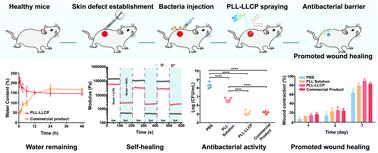当前位置:
X-MOL 学术
›
J. Mater. Chem. B
›
论文详情
Our official English website, www.x-mol.net, welcomes your
feedback! (Note: you will need to create a separate account there.)
A bacteria-resistant and self-healing spray dressing based on lyotropic liquid crystals to treat infected post-operative wounds
Journal of Materials Chemistry B ( IF 6.1 ) Pub Date : 2021-08-24 , DOI: 10.1039/d1tb01201k Xiao Yue 1, 2 , Xuejuan Zhang 1 , Chen Wang 2 , Ying Huang 1 , Ping Hu 1 , Guanlin Wang 2 , Yingtong Cui 2 , Xiao Xia 1 , Ziqiang Zhou 1 , Xin Pan 2 , Chuanbin Wu 1
Journal of Materials Chemistry B ( IF 6.1 ) Pub Date : 2021-08-24 , DOI: 10.1039/d1tb01201k Xiao Yue 1, 2 , Xuejuan Zhang 1 , Chen Wang 2 , Ying Huang 1 , Ping Hu 1 , Guanlin Wang 2 , Yingtong Cui 2 , Xiao Xia 1 , Ziqiang Zhou 1 , Xin Pan 2 , Chuanbin Wu 1
Affiliation

|
The delayed healing of infected post-operative wounds has turned into a worldwide medical problem. In the clinical treatment, effective bacterial clearance and promoted wound healing were considered as two crucial aspects. However, the effect of current dressings with antibacterial activity was limited due to the declined efficacy against antibiotic-resistant bacteria, and poor mechanical property during skin extension and compression movement. In this project, a lyotropic liquid crystal (LLC)-based bacteria-resistant and self-healing spray dressing loaded with ε-polylysine (PLL) was designed. Owing to the unique antibacterial mechanism, PLL was expected to kill antibiotic-resistant bacteria efficiently, even the “superbug” methicillin-resistant Staphylococcus aureus (MRSA). The cubic cells of LLC were applied to encapsulate PLL to improve its stability and induce a sustained release, further realizing a long-term antibacterial effect. Meanwhile, the LLC precursor (LLCP) could extend to the irregular edges of the wound, and spontaneously transited to a cubic phase gel once exposed to physiological fluid. This 3D structure was also endowed with mechanically responsive viscoelasticity that formed a robust and flexible defense for wounds. An excellent antibacterial activity with more than 99% MRSA killed in 3 h was demonstrated by a killing kinetics study. The long-term effect was also proved by measuring the bacteriostatic circle test within 48 h. In addition, the unique sol–gel phase transition behavior and superior self-healing capacity of PLL-LLCP was verified with the rheological study and self-recoverable conformal deformation test in vivo. In the infected post-operative wound model, satisfactory bacterial clearance and prominent wound healing promotion were realized by PLL-LLCP, with the survival of the bacteria at lower than 0.1% and the wound closure at higher than 90%. Thus, PLL-LLCP was believed to be an excellent candidate for the therapy of infected post-operative wounds.
中文翻译:

一种基于溶致液晶的抗菌自愈喷雾敷料,用于治疗感染的术后伤口
感染的术后伤口愈合延迟已成为一个世界性的医学问题。在临床治疗中,有效的细菌清除和促进伤口愈合被认为是两个关键方面。然而,目前具有抗菌活性的敷料的效果有限,因为其对抗生素耐药性细菌的功效下降,以及皮肤伸展和压缩运动过程中的机械性能较差。在本项目中,设计了一种负载 ε-聚赖氨酸 (PLL) 的基于溶致液晶 (LLC) 的抗菌自愈喷雾敷料。由于独特的抗菌机制,PLL有望有效杀死耐抗生素细菌,甚至是“超级细菌”耐甲氧西林金黄色葡萄球菌(MRSA ))。将LLC的立方细胞用于包裹PLL以提高其稳定性并诱导缓释,进一步实现长效抗菌作用。同时,LLCP前体(LLCP)可以延伸到伤口的不规则边缘,一旦暴露在生理液中,就会自发转变为立方相凝胶。这种 3D 结构还具有机械响应的粘弹性,可形成坚固而灵活的伤口防御。具有出色的抗菌活性,含有超过 99% 的MRSA杀死动力学研究证明了在 3 小时内被杀死。通过测量 48 小时内的抑菌圈试验也证明了长期效果。此外,PLL-LLCP独特的溶胶-凝胶相变行为和优越的自愈能力通过体内流变学研究和自恢复保形变形试验得到验证。在感染的术后伤口模型中,PLL-LLCP实现了令人满意的细菌清除和显着的伤口愈合促进,细菌存活率低于0.1%,伤口闭合率高于90%。因此,PLL-LLCP 被认为是治疗感染的术后伤口的绝佳候选者。
更新日期:2021-09-08
中文翻译:

一种基于溶致液晶的抗菌自愈喷雾敷料,用于治疗感染的术后伤口
感染的术后伤口愈合延迟已成为一个世界性的医学问题。在临床治疗中,有效的细菌清除和促进伤口愈合被认为是两个关键方面。然而,目前具有抗菌活性的敷料的效果有限,因为其对抗生素耐药性细菌的功效下降,以及皮肤伸展和压缩运动过程中的机械性能较差。在本项目中,设计了一种负载 ε-聚赖氨酸 (PLL) 的基于溶致液晶 (LLC) 的抗菌自愈喷雾敷料。由于独特的抗菌机制,PLL有望有效杀死耐抗生素细菌,甚至是“超级细菌”耐甲氧西林金黄色葡萄球菌(MRSA ))。将LLC的立方细胞用于包裹PLL以提高其稳定性并诱导缓释,进一步实现长效抗菌作用。同时,LLCP前体(LLCP)可以延伸到伤口的不规则边缘,一旦暴露在生理液中,就会自发转变为立方相凝胶。这种 3D 结构还具有机械响应的粘弹性,可形成坚固而灵活的伤口防御。具有出色的抗菌活性,含有超过 99% 的MRSA杀死动力学研究证明了在 3 小时内被杀死。通过测量 48 小时内的抑菌圈试验也证明了长期效果。此外,PLL-LLCP独特的溶胶-凝胶相变行为和优越的自愈能力通过体内流变学研究和自恢复保形变形试验得到验证。在感染的术后伤口模型中,PLL-LLCP实现了令人满意的细菌清除和显着的伤口愈合促进,细菌存活率低于0.1%,伤口闭合率高于90%。因此,PLL-LLCP 被认为是治疗感染的术后伤口的绝佳候选者。









































 京公网安备 11010802027423号
京公网安备 11010802027423号